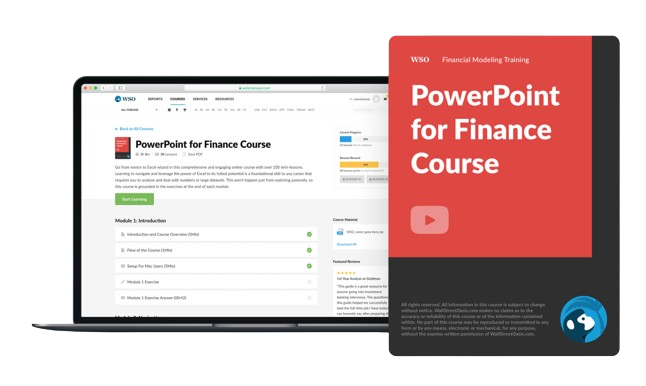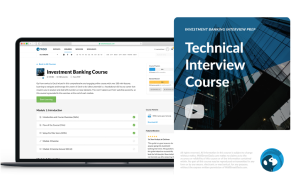Investment Banking Pitch Book
A structured PowerPoint presentation created to attract new businesses
What Is An Investment Banking Pitch Book?
An investment banking pitch book is a marketing document created by investment bankers to present to potential clients. The primary objective of this document is to showcase the bank's credentials, services, and value proposition in the hopes of winning business mandates from clients.
Essentially, it's a sales tool, and its effectiveness can be a key determinant in securing deals. The pitch highlights the bank's expertise in transaction procedures, demonstrating why the client should choose the bank for their financial needs.
The initial steps of the pitching process can vary greatly depending on the relationship with the customer and the type of traction.
Banks and investment firms prepare pitch books to facilitate the sale of products and services by listing the company's key characteristics. In addition, pitch books are helpful guides for sellers to remember key benefits and provide visual aids when presenting to customers.
Presentation books are helpful guides for sellers to remember key benefits and provide visual aids when presenting to customers.
In investment banking, pitch books refer to the selling point used by a bank to persuade a prospective client to take action and pay for the bank's services.
Pitch books frequently feature sections on:
- The transaction's virtues
- Analysis of prospective buyers or sellers
- Price and rating information
- Important risks to consider
The effectiveness of pitch books can vary, and their importance depends on the specific situation and the quality of the content.
Most of the time, bankers close deals through enduring relationships. The strong relationships between the chief executive and chief financial officers, built on trust and prior experiences, are more important than a strong presentation before a company goes public.
Key Takeaways
- Investment banking pitch books are structured PowerPoint presentations designed to attract new business. They articulate why the bank is the best choice for transaction processes and why clients should opt for its services.
- Investment Banking Pitch books outline key characteristics of a business and serve as guidelines for the sales force, providing essential information about the company.
- Creating an investment banking pitch book is a joint effort involving junior and senior bankers, with analysts and investment banking personnel doing most of the work.
- The process of creating pitch books can be complex, involving challenges such as conflicting changes in content and design preferences.
- Despite the effort put into pitch books, building enduring relationships often plays a more critical role in closing deals than the presentation alone.
What's Included In An Investment Banking Pitch Book?
In general, the process of creating a pitch book is fairly standard and follows the structure below:
- Format: Title, Date, and Title logos
- Index: All sections of the pitchbook
- Executive Summary/Situation Summary: Explains why you keep the presentation and CTA/Recommendation on one page
- Introduce the key team members and briefly overview the bank's expertise, highlighting relevant experience and achievements. Clearly define the purpose of discussing the bank's history with the customers.
- Market Overview: Tables, charts, and analysis outlining the state of the market and consumer trends.
- Valuation: Valuation methods include comparative analysis of companies, historical transactions, and DCF analysis
- Transaction strategy: details of the bank's strategy
- Summary: Summarize why the team and bank are best suited to conduct the transaction and how the environment can do so, e.g., that the market is relevant, the valuation it deems feasible, and the bank's strategy. There may be problems with trading, but it does not belong in the ledger queues
- Annexure: May contain a variety of information within the offer but mainly supporting information that the bank deems questionable but which is not pertinent to the main stock ledger, e.g., assumptions/model details
Pitch Book Presentations Structure
As briefly mentioned, an investment bank, corporate finance firm, or other M&A intermediary that advises on the sale or disposal of shares or assets of a business uses a pitch book (or pitch deck) as a marketing presentation.
Presentations like this serve as information layouts and usually consist of the following elements:
- Introduce Your Team and Firm Profile
- The first section of the Investment Banking Pitch Books introduces your firm's platform, recent transactions, and the team.
- You can add statistics about your company's position in the rankings or explain your growth story and how you differ from your competitors.
- You can also discuss distribution alliances and other strategic developments in this section.
- The credentials in the next section include information on transactions your rivals have carried out that are comparable to yours. These lists frequently contain transactions done by staff at other banks due to the high rate of bank turnover.
- These pages look simple, but putting them together can be time-consuming as you have to find the most relevant offers and rearrange elements from other presentations.
- You can also go into some agreements in more detail and devote entire pages to them.
- This part concludes with a biography of the team, detailing former employers, pertinent transactions, and clients.
- Providing Background and Context
- Before moving on to the specific situation of the company you are meeting with, you typically share some news about the industry and recent business activity.
- Strategic Mandates Selection
- Sell-side mandates involve persuading a company to sell itself, employing various strategies to maximize value for the client and facilitate the sales process.
- Acquisition mandates involve convincing a company to acquire another entity, necessitating thorough market analysis, negotiation skills, and strategic planning.
- Financing mandates encompass raising debt or capital through various financial instruments tailored to meet the client's specific financial needs and optimize their capital structure.
How Is The Pitch Book Actually Made?
Pitch book creation involves collaboration between junior and senior bankers, analysts, and investment banking personnel. Analysts and investment banking personnel are primarily responsible for the detailed work involved.
Typically, a director (who has a relationship with the client) sits down with the vice president to conduct a general review of the bid book.
The vice president or director then puts together the presentation structure and has the associate work with the analyst to pull together all the numbers and create the analysis used to complete the presentation.
For an investment firm, the presentation book would be more product-oriented. For example, it could show the history of an investment portfolio through charts and comparisons with an appropriate benchmark.
If the investment strategy is more advanced, it will show the stock selection method and other information to help the prospective client understand the strategy.
Example
In 2011, Autonomy was acquired by several larger competitors. Hewlett-Packard and Oracle were interested, but HP ultimately prevailed and acquired the software infrastructure company.
Oracle has decided to publish an IPO launch book developed by Qatalyst Partners on its website.
In the introductory book, Qatalyst provides examples of how Oracle would benefit from the acquisition of Autonomy and shows that it would increase its competitive advantage in areas where Oracle could not gain a foothold.
It also showed the company's key financials and how it had positive revenue and margin growth. The book also introduced the partners and customers Oracle would acquire immediately after purchasing the company. It went into detail about the Autonomy of the management team and the directors.
Sell-Side Pitch Books
Let's take a look at the pitch for the Sell-Side Pitch Books:
- First, provide a few slides outlining how your bank will market the business and make it appealing to potential purchasers.
- Next, present the company's valuation and the price you might expect to sell it. This evaluation section can be as little as 12 slides in a short presentation book or more than 20 slides in a longer one.
- Common elements include the "soccer field" valuation chart, DCF model output, comparable public companies, and historical transactions. These all make the presentation more visually appealing and comprehensible.
- "Soccer field" or rating summary pages vary in complexity, from basic representations to intricate charts designed to provide detailed insights. Including a Contribution Analysis or M&A Analysis in this section is common if the business is very specific or advanced.
- Last but not least, longer investment banking presentation books frequently tend to include an appendix with more thorough models, statistics, and relatively longer lists of potential buyers.
Buy-Side Pitch Books
Investment banking submission books for M&A purchase transactions follow a similar structure, with a few key differences. The primary distinction is that in buy-side deals, the bank actively facilitates the transaction closure process.
In sales contracts, key goals include:
- Valuing the buyer
- Assessing potential stock issues
- Securing funding
- Swiftly evaluating potential acquisition targets to facilitate the transaction process
Unlike sell-side deals focusing on potential buyers, buy-side submissions focus on profiling potential targets. Considering large firms might consider hundreds or thousands of targets, this list is generally broader than potential buyer lists.
Buy-side transactions share similarities with generic pitch books in structure. However, they emphasize the type of acquisition and employ a unique valuation structure. This structure determines stock distribution based on the estimated value of the buyer.
Moreover, their profiling algorithm tends to be significantly more inclusive, emphasizing potential targets rather than just acquirers.
Hence, the importance of this stage cannot be stressed enough, as it lays the foundation for the business flow operation and is thus typically conducted by senior analysts.
To avoid repetitiveness in acquisition targets, large companies sometimes engage external bankers to ensure the authenticity and diversity of potential targets.
Note
Proposing a unique and original business concept captures the firm's interest, as opposed to suggesting ideas that have been previously heard, which may not generate enthusiasm.
Researched and authored by Ayoub Mresa | LinkedIn
Free Resources
To continue learning and advancing your career, check out these additional helpful WSO resources:





or Want to Sign up with your social account?